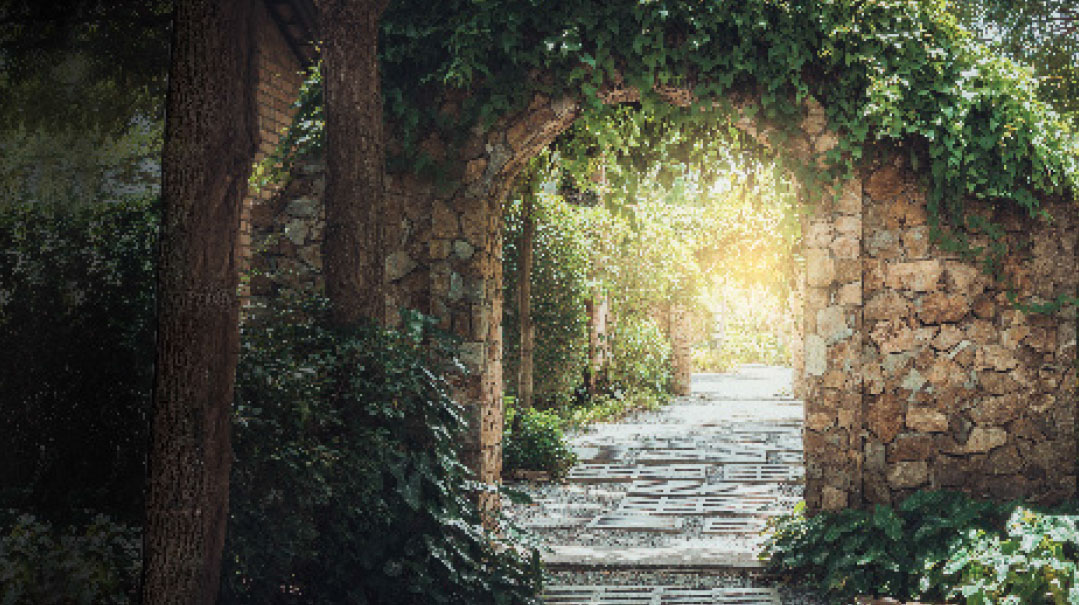An Eden of One’s Own

The longing for the peace and beauty a garden can provide has taken many forms throughout the years

It’s summer in Eretz Yisrael. The flowers have burst into gaudy bloom in cozy clusters, blissfully unaware of the rules of social distancing we humans have had to endure these past few months. Indeed, gardens — whether cultivated for the pleasure of kings, or for more humble uses and people — have always been prized for their ability to take us away from our concerns and connect us with something eternal.
But recreating a bit of Eden has meant different things in different times and places. Join us for a stroll down the path as we take a look at gardens throughout the ages.
In the Beginning
And the earth brought forth vegetation, plants yielding seed after their kind, and trees bearing fruit with seed in them, after their kind; and G-d saw that it was good. —Bereishis 1:12
Adam Harishon was tasked with tending the garden on the very day he was created. And ever since, man has been caring for the land.
In the post-Eden world, cultivating food — producing vines, trees, and shrubs — continued, using a type of gardening that historians call forest gardening. The term “forest” is used because the vegetation was grown close together in an enclosed area. This made it easier to harvest the bounty — and protect the precious food source from wandering animals and marauders.
As people became more expert at irrigation (and defense) techniques, the variety and layout expanded. An average gardener living in ancient Israel might cultivate the Seven Species — wheat, barley, grapes, figs, pomegranates, olives, and dates — and also cucumbers, melons and gourds, onions and garlic, and spices such as cumin, coriander, and mustard.
A king’s garden would be even more varied and elaborate, as we know from Shir Hashirim. Shlomo Hamelech describes such a garden in 4:12–16. In this walled garden, there’s a pomegranate orchard, fragrant spices such as cinnamon, frankincense, and myrrh, as well as a fountain. A garden like this would both produce food for the royal palace and provide a shaded space to relax in, where the royals could enjoy the many colors and fragrances.
Oasis in the Ancient World
A myrtle that stands among thorns is still a myrtle. —Sanhedrin 44a
Of course, the Jews weren’t the only ones to cultivate gardens in the ancient world. Ancient Egypt had its fruit orchards and vegetable gardens, which were irrigated with water from the Nile. Wealthy Egyptians had pleasure gardens filled with shade trees and flowers, as well as ponds stocked with fish and waterfowl. Some even recreated their gardens either as a painting or a miniature model in their tombs, to enjoy in the afterlife.
In Mesopotamia — home to the Sumerians, Akkadians, Assyrians, and Babylonians — the “power garden” became popular, as kings vied to show off their wealth and even their military prowess through horticulture. In a sculpture depicting the enclosed Courtyard Garden constructed by Assurbanipal, a seventh-century BCE Assyrian king, he and his queen are shown dining in a vine-covered arbor whose “decorations” include the severed head of the king of Elam.
An earlier Assyrian monarch, Ashurnasirpal II, was among the first to develop the concept of the City Garden, where river water was diverted into a large-scale landscaped garden located within a city’s walls. According to a historical account, Ashurnasirpal’s garden was filled with an impressive variety of trees and vines — pine, cypress, juniper, almond, date, ebony, rosewood, olive, oak, tamarisk, walnut, terebinth, ash, fir, pomegranate, pear, quince, fig, and grapevines — and irrigated by “streams of water as numerous as the stars of heaven.” This led the happy monarch to proclaim, “Like a squirrel, I pick fruit in the garden of delights.”
A century later, another Assyrian king, Sancheriv — who famously failed to capture Jerusalem when a plague decimated his army — claimed to have outdone his predecessors with the city garden he built in Nineveh, using the latest in irrigation technology. “A wonder for all peoples,” is how he modestly described his achievement.
Oops! We could not locate your form.







